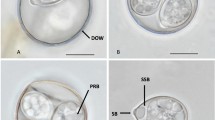Abstract
Faecal samples were collected from four 8 days old snow bunting nestlings from one nest in Ny-Ålesund, Spitsbergen, in summer 2006. After sporulation, samples were examined for coccidian parasites using flotation centrifuging. We found isosporan oocysts in three birds, intensity of infection varied between individuals from 35 to 6,000 oocysts per defecation. All oocysts belonged to one species, which is described here as a new species. The spherical or subspherical oocysts (Fig. 1) have a brownish, smooth, relatively thin (about 1.1 μm) bilayered wall. Average size of sporulated oocysts was 26.2 ± 0.13 × 23.6 ± 0.16 μm (24.1–28.4 × 21.5–26.9; n = 10) with a shape index (length/width) of 1.11 ± 0.01 (1.01–1.29). The sporulated oocysts have no micropyle or residuum but enclose one large (3.3 × 2.8 μm) ring-formed polar granule. The sporocysts are ovoidal, slightly pointed at the end opposite the Stieda body, 18.2 ± 0.06 × 9.9 ± 0.03 μm (17.1–19.0 × 9.0–10.8; n = 14), shape index 1.85 ± 0.008 (1.70–1.99). The Stieda body has a prominent knob-like cap and a well-visible round substieda body. Sporocysts contain compact sporocyst residuum composed of small, uniform granules and sporozoits with usually three large refractile bodies and a smaller nucleus. The prepatent period is less than 8 days. This is the first description of an avian isosporan parasite that succeeds transmission while in the High Arctic.


Similar content being viewed by others
References
Box ED (1980) Isospora as an extra-intestinal parasite of passerine birds. Prog Abstr Am Soc Parasitol 55:39–40
Černá, Ž (1973) Interesting coccidians from wild birds. J Protozool 20:535–536
Dolnik OV (2002) Isospora sylvianthina (Protozoa: Coccidiida), parasite of Blackcap, does not infect Reed Warbler. Zoosyst Ross 10:240
Dolnik O (2006) The relative stability of chronic Isospora sylvianthina (Protozoa: Apicomplexa) infection in blackcaps (Sylvia atricapilla): evaluation of a simplified method of estimating isosporan infection intensity in passerine birds. Parasitol Res 100:55–60
Duszynski DW (1999) Critical comment: revisiting the code: clarifying name-bearing types for photomicrographs of protozoa. J Parasitol 85:769–770
Pellerdy LP (1974) Coccidia and coccidiosis. Akademiai Kiado, Budapest Hungary
Levine ND (1982) Isospora passeris n. sp. from the house sparrow Passer domesticus, I. lacazei, and related apicomplexan Protozoa. Trans Am Microsc Soc 101:66–74
Levine ND, Ivens V (1988) Cross-Transmission of Eimeria spp. (Protozoa, Apicomplexa) of rodents—a review. J Eukaryot Microbiol 35:434–437
Long PL (ed.) (1982) The biology of the Coccidia. Edward Arnold, London, UK.
McDougald LR (1979) Attempted cross-transmission of coccidia between sheep and goats and description of Eimeria ovinoidalis sp. n. J Protozool 26:109–113
Svobodová M (1994) Isospora, Caryospora and Eimeria (Apicomplexa: Eimeriidae) in Passeriform Birds from Czech Republic. Acta Protozool 33:101–108
Upton SJ, Wilson SC, Norton TM, Greiner EC (2001) A new species of Isospora Schneider, 1881 (Apicomplexa: Eimeriidae) from the Bali (Rothschild’s) mynah Leucopsar rothschildi (Passeriformes: Sturnidae), and comments concerning the genera Atoxoplasma Garnham, 1950 and Isospora. Syst Parasitol 48:47–53
Author information
Authors and Affiliations
Corresponding author
Rights and permissions
About this article
Cite this article
Dolnik, O.V., Loonen, M.J.J.E. Isospora plectrophenaxia n. sp (Apicomplexa: Eimeriidae), a new coccidian parasite found in Snow Bunting (Plectrophenax nivalis) nestlings on Spitsbergen. Parasitol Res 101, 1617–1619 (2007). https://doi.org/10.1007/s00436-007-0703-8
Received:
Accepted:
Published:
Issue Date:
DOI: https://doi.org/10.1007/s00436-007-0703-8




